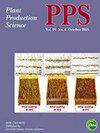利用QTL-seq鉴定二倍体野生甘薯根厚的主要QTL
IF 1.3
3区 农林科学
Q2 AGRONOMY
引用次数: 1
摘要
摘要:甘薯的近亲三叶甘薯一般不形成贮藏根,但有些品系的根系较粗,与甘薯的贮藏根相似。揭示甘薯厚根发育的分子机制,有助于我们了解甘薯贮藏根的进化。在本研究中,我们进行了一种被称为QTL-seq的数量性状基因座(QTL)定位方法,这是一种基于下一代测序的批量分段分析。我们使用来源于两个I.trifida品系的回交群体(BC1F1)进行QTL-seq:Mx23Hm,其不显示根增厚;0431-1产生厚根。目的是鉴定与厚根发育有关的QTL区域。因此,在盆栽和田间试验中,在Itr_r2.2的chr06的2.94–8.71Mb区域都检测到了根厚的主要QTL(qRT1)。在chr06上使用InDels为qRT1设计了六个DNA标记。基于这些DNA标记对每个BC1F1个体进行基因分型与QTL-seq的SNP指数非常一致。此外,在BC2F2群体中,大多数具有qRT1 0431-1型等位基因的个体比没有qRT1的0431-1-型等位突变的个体长出更厚的根。本研究结果表明,qRT1是一个重要的QTL,可调控三叶草根系厚度。图形摘要本文章由计算机程序翻译,如有差异,请以英文原文为准。
Identification of a major QTL for root thickness in diploid wild sweetpotato (Ipomoea trifida) using QTL-seq
ABSTRACT Ipomoea trifida, the closest relative of sweetpotato, does not generally form storage roots, but some lines develop thick roots similar to the storage roots of the sweetpotato. Revealing the molecular mechanism of thick root development in I. trifida would help us understand the evolution of storage roots in the sweetpotato. In this study, we conducted a mapping method for quantitative trait loci (QTLs) known as QTL-seq, which is a kind of next-generation sequencing-based bulk segregant analysis. We performed QTL-seq using a backcross population (BC1F1) derived from two I. trifida lines: Mx23Hm, which does not show root-thickening; and 0431-1, which produces thick roots. The aim was to identify the QTL region involved in thick root development. As a result, a major QTL for root thickness (qRT1) was detected in the 2.94–8.71 Mb region of chr06 of Itr_r2.2, in both pot and field experiments. Six DNA markers were designed for qRT1 using InDels on chr06. Genotyping each BC1F1 individual based on these DNA markers agreed well with the SNP-Index of QTL-seq. Moreover, most individuals with 0431-1-type alleles of qRT1 developed thicker roots than individuals without 0431-1-type alleles of qRT1 in the BC2F2 population. The results of this study implied that qRT1 was an important QTL for regulating root thickness in I. trifida. GRAPHICAL ABSTRACT
求助全文
通过发布文献求助,成功后即可免费获取论文全文。
去求助
来源期刊

Plant Production Science
农林科学-农艺学
CiteScore
5.10
自引率
4.00%
发文量
27
审稿时长
>36 weeks
期刊介绍:
Plant Production Science publishes original research reports on field crops and resource plants, their production and related subjects, covering a wide range of sciences; physiology, biotechnology, morphology, ecology, cropping system, production technology and post harvest management. Studies on plant production with special attention to resource management and the environment are also welcome. Field surveys on cropping or farming system are also accepted. Articles with a background in other research areas such as soil science, meteorology, biometry, product process and plant protection will be accepted as long as they are significantly related to plant production.
 求助内容:
求助内容: 应助结果提醒方式:
应助结果提醒方式:


